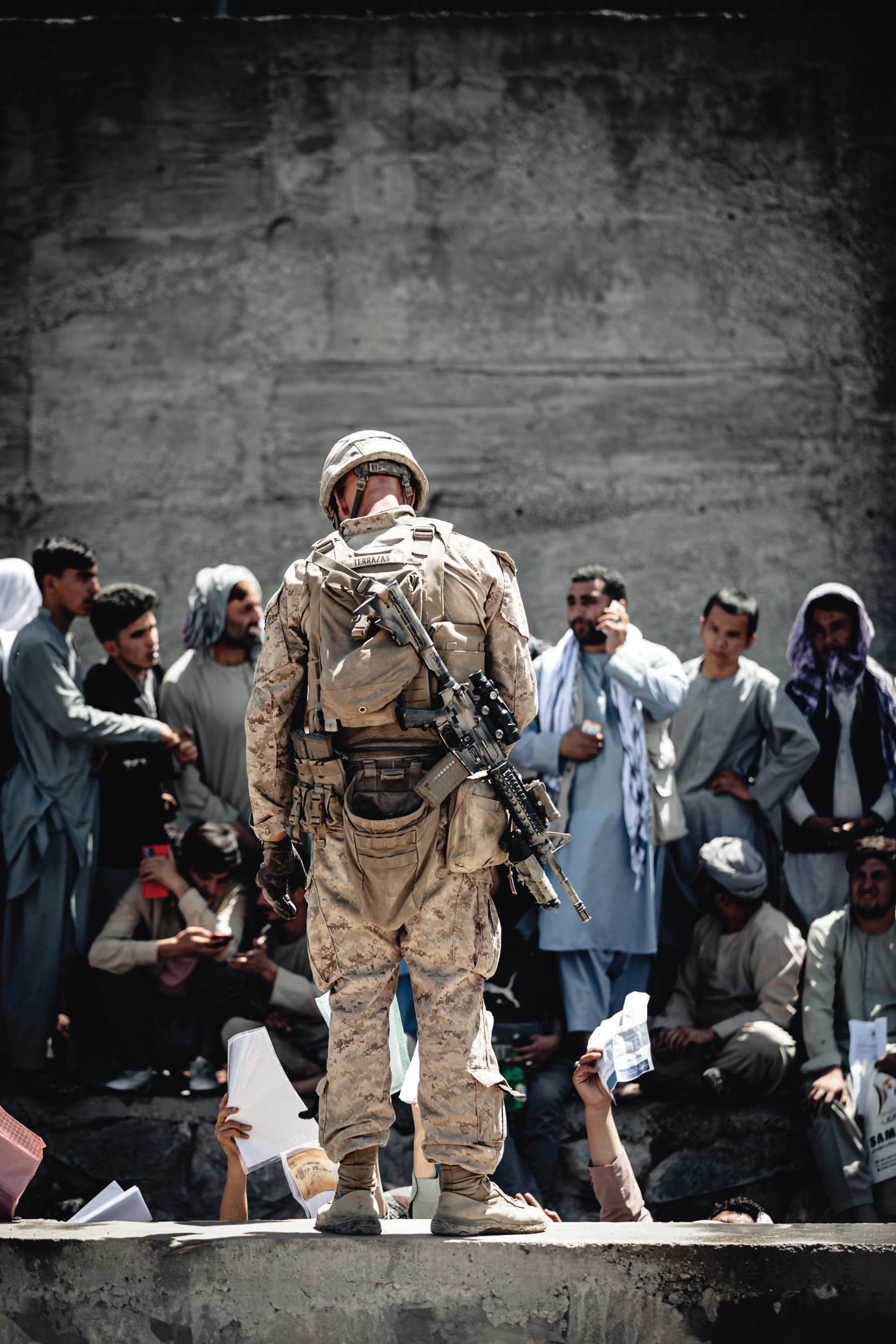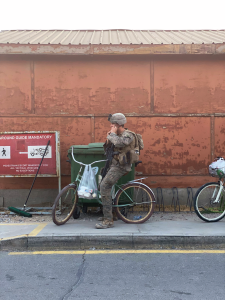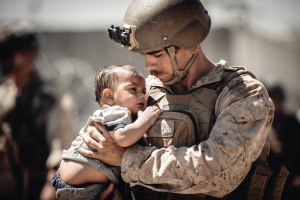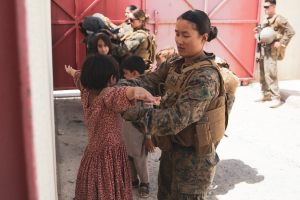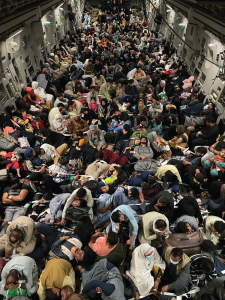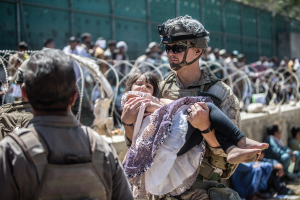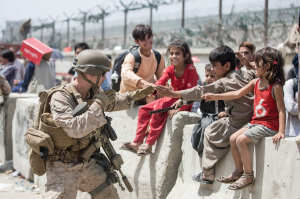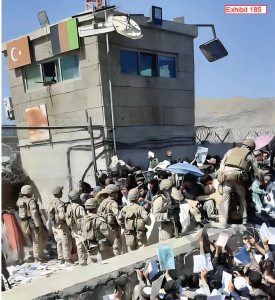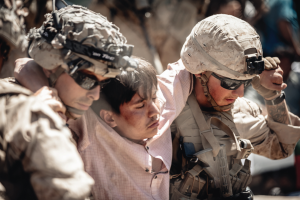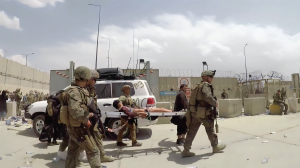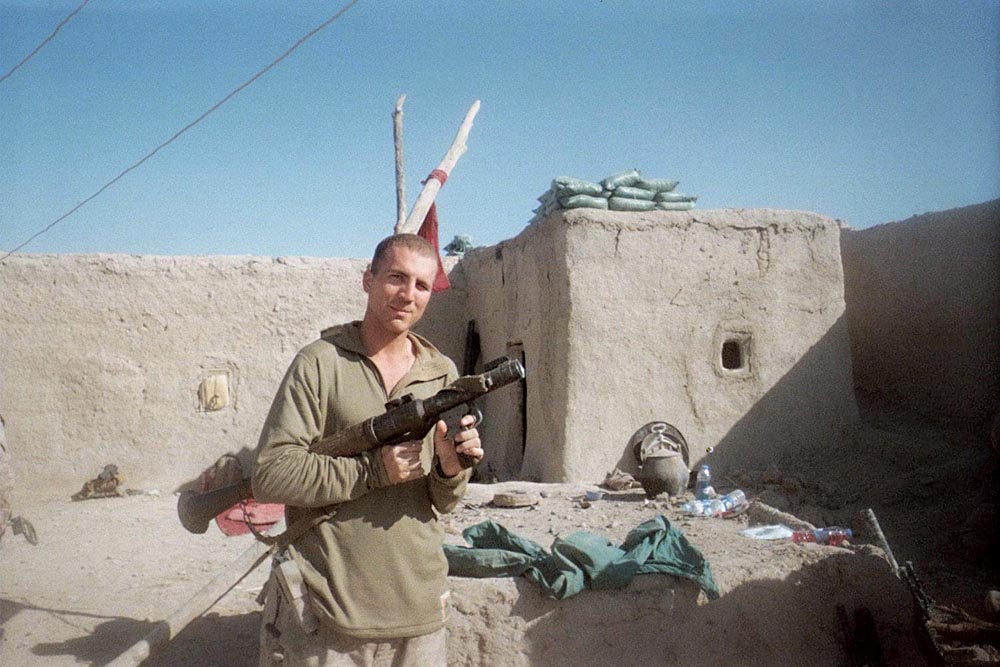By Kyle Watts
The U.S. Air Force C-17 began its final descent in preparation for landing. Corporal Von Straight sat packed in among the 25 Marines of his stick. Gear of every sort filled the expansive interior of the aircraft, leaving barely enough room for the Marines, as Straight contemplated the mission ahead. What that mission was he did not fully understand, but it was Afghanistan. After watching Marines fight there for most of his life, Straight yearned to finally have his turn. Would it be a fight, though? Nobody seemed to know. The Marines aboard the plane could never have imagined the world in which they were about to spend the next two weeks.
The aircraft touched down at Hamid Karzai International Airport (HKIA) in the capital city of Kabul during the early morning hours of Aug. 14, 2021. A few other personnel from 1st Battalion, 8th Marines had arrived earlier, but as a combat engineer, Straight’s squad arrived with the advance party.
Events on the ground outside the airport had decayed rapidly over the weeks prior. The Afghan government and military, propped up by the U.S., collapsed under a Taliban onslaught in every city and province. After vacating Bagram Air Base on July 1, the airfield at HKIA stood as the last American toehold in the country. U.S. soldiers and Marines from Joint Task Force-Crisis Response operated out of HKIA preparing for the possibility of a noncombatant evacuation operation (NEO). The 24th Marine Expeditionary Unit, with 1/8 attached, and Central Command’s Special Purpose Marine Air Ground Task Force, with 2nd Battalion, 1st Marines attached, were called in for support as the situation deteriorated.
As Cpl Straight prepared for the coming evacuation, the entire world watched events happening outside the perimeter wall. On Aug. 15, Taliban forces surrounded Kabul and Afghan President Ashraf Ghazi fled the city with numerous other officials of the American-backed government. Afghan army soldiers threw away their weapons and melted into the civilian populace. Taliban flooded the city and seized control of the country. American helicopters evacuated more than 5,000 personnel still on the ground at the U.S. embassy.
News of the takeover spread quickly, and civilians massed at the airport in fear for their lives. The sudden lack of Afghan soldiers left holes on the airfield perimeter, and crowds seized the opportunity.
Straight was working with his team processing civilian contractors for evacuation as night fell on the 15th when a frantic call suddenly rose over the radio. Someone across the airfield said they were under fire and civilians had breached the perimeter. The Marines joined forces with Turkish soldiers and moved out. Ambient city lights washed out all night vision devices so vehicles trailed the line of Marines pushing over the open ground, illuminating their way.
Sparks jumped off the tarmac in front of Straight. A vehicle-mounted machine gun behind him opened up on a shadowy figure hiding in a ditch. As they continued, a C-17 lumbered through the darkness down the runway. Marines dodged the aircraft and took cover as it throttled up on an emergency takeoff. Farther ahead, a line of black-clad men carrying AK-47s sprinted across the field. By the time the sighting made its way up the chain for permission to engage, the men disappeared into a distant crowd.
Two shots cracked through the air past Straight’s head. He stopped in his tracks. He’d never been shot at before.
“My platoon sergeant standing next to me started dying of laughter as he saw the thought process working through my head,” Straight recalled. “My first thought was that I was not wearing my eye protection, like I was on another damn field exercise at Lejeune or something. We saw the guy who shot at us on the edge of a crowd, but he disappeared. Things just got progressively worse from there.”
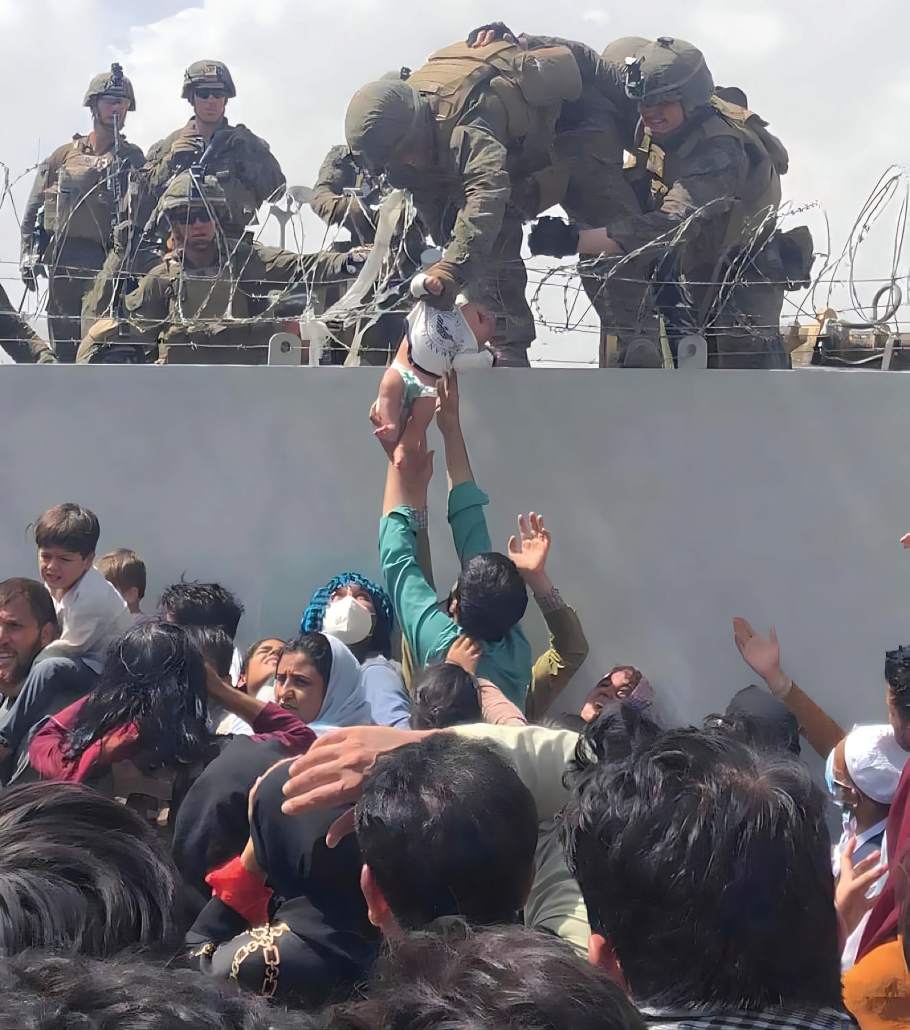
When dawn rose on the 16th, just a few hundred Marines and U.S. Army soldiers occupied the airfield amid a rising tide of civilians. Estimates range as high as 24,000 civilians breaching the perimeter. A brief and unintended firefight broke out between Marines and Taliban with two Taliban killed. Air Force airplanes made last-minute emergency takeoffs through the crowds on the runway. At midday, civilians on the ground recorded the now infamous footage of people clinging to the outside of a C-17 and bodies plummeting from the sky as they lost their grip after lifting off. Apache helicopters flew back and forth over the flight line mere feet off the ground, forcing people back with their rotor wash. Nothing worked. The crowd proved largely peaceful but refused to budge.
The swell of people reduced as night fell. No planes would land or take off as long as they remained on the tarmac. Afghan special forces arrived and used extreme crowd control tactics, beatings and shooting civilians who stubbornly refused to retreat. Finally, after more than 24 hours of effort to regain control, U.S. forces reopened the airfield.
Cpl Mike Markland waited in Qatar with the remainder of 1/8 for a flight to Kabul as different news agencies reported the fall of the city to the Taliban. Some Marines were told to prepare for a landing under fire. No one knew what to expect or what was happening on the ground.
As Markland’s C-17 waited for permission to take off, another aircraft landed nearby and stopped on the runway. The aircrew from Markland’s plane exited and ran over. Marines stirred and grumbled over the delay as the C-17 crews gathered around the landing gear of the other plane. Markland eventually learned that the body of an Afghan civilian remained lodged inside the aircraft, crushed beneath the landing gear and frozen solid by the frigid temperatures at high altitude during the flight.
Markland’s plane finally departed and arrived at HKIA on the night of the 16th after the airfield was secure. Upon their arrival, the Marines from 1/8 set up around the north and east gates of the airport to process civilians for evacuation. Markland reached North Gate and climbed above the wall. People were spread out as far as his eyes could see. Strands of concertina wire placed outside the wall lay flat beneath discarded clothes, luggage, and bodies shoved over them.
Marines pushed outside the gate, fighting to create space between the wall and the crowd. They screamed at the top of their lungs for people to get back or sit down. Civilians screamed back at the Marines and at each other, holding aloft every kind of paperwork imaginable that they hoped could get them out of the country. Marines scanned for threats as civilians crushed in, and warning shots filled the air, originating from any nationality present with a rifle. Taliban soldiers lurked along a road running parallel to the wall less than 100 meters away beating and shooting people who didn’t comply with their orders. Afghan army soldiers waded into the crowd outside the gate beating and shooting people for the same reasons.
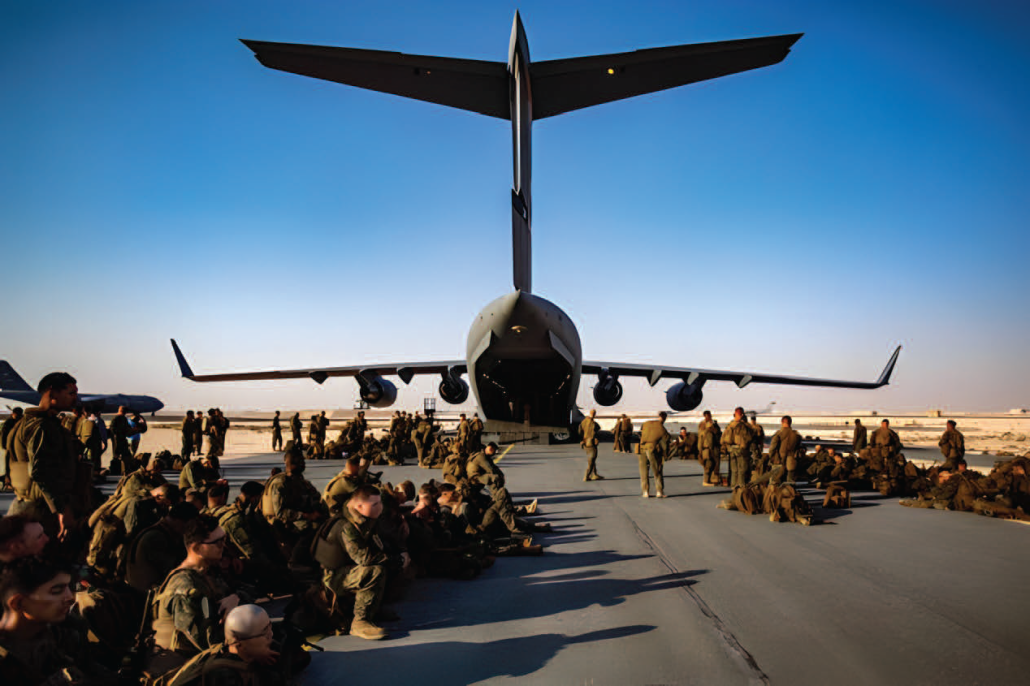
“Nothing in your life gets you ready for something like that,” reflected Markland. “I was immediately met with something so different from anything I ever thought I would encounter; a situation I never even realized could happen with humanity. Everything you’ve learned as a man and as a Marine is constantly being used. It became exhausting very quickly.”
The young Marines knew Afghanistan as a war zone for all of their lives. Many of the older Marines had fought there on previous deployments but were now there under the pretense of an NEO, not combat, and they expected some form of order to make that happen. The chaos that greeted them left everyone looking to each other to determine what was acceptable and what was not.
“We wanted so badly to help these people,” Markland said, “but the only thing messing up the order and regulation of everything was the people. It’s like a two-edged sword. Any time you help one person, everyone sees that, and they get all riled up.”
In one example outside North Gate, Cpl Benjamin Lowther stood shoulder to shoulder with other Marines keeping civilians back. The crowd grew agitated and surged ahead. Warning shots and screaming filled the air. Suddenly, a can of tear gas erupted in the middle of it all. No one knew who threw it—a Marine, ANA soldier, or one of the other nationalities present. Marines withdrew back toward the gate to shut down processing until the crowd settled. As Marines backed away from the gas, civilians pushed ahead into the void, crushing some of their own beneath the weight of an unstoppable mass.
Their momentum pinned Cpl Lowther against a thigh-high jersey barrier. He drew his service pistol and fired into the air but could not create enough space to free his legs. He shouted for help and two Marines grabbed hold of his gear. Pulling at his belt and flak jacket, they finally freed his feet and safely returned behind the gate.
Marines hardened themselves to maintain their sanity. One of the worst duties involved returning “rejected” civilians back outside the gate. With limited guidance from the Department of State (DOS) on what paperwork a civilian needed for evacuation, Marines ushered in people who did not meet the criteria. Other times, foreign nations brought in large groups without proper vetting and left them at the Marines’ entry control point. On one occasion, Cpl Markland helped bring in a man who had been shot in the genitals. They rushed him to medical care, but when he was stabilized, were forced to bring the man back outside the wall because he had no paperwork. Many other men, women, and children were forced back outside. Civilians resisted, begging Marines to let them stay, or pleading for the Marines to kill them. Unbelievably, they deemed this a more merciful death than being thrown out and left once more to the Taliban.
At the same time as 1/8 occupied North and East gates, 2/1 touched down in waves and moved to Abbey Gate. Unlike a typical combat deployment, the Marines arrived lacking much of the gear that normally came with them. They relied on whatever they could carry, but Marines being Marines, they quickly adapted.
“It’s like if Stephen King and Dr. Seuss got together and wrote a book, that would be all of HKIA,” recalled Gunnery Sergeant Melissa Marnell, a combat photographer attached to 2/1. “It was like the Wild West. Marines were doing anything they could to get by. I saw rifle squads traveling on bicycles, or entire sections moving on bulldozers or fire engines. I had no idea so many Marines knew how to hot-wire vehicles. If you found a vehicle and could get it started, spray paint your name on the side, and it was yours.”
Sergeant Dalton Hannigan served as the assistant team leader for a seven-man sniper team called Reaper 2. He went to work “acquiring” assets. An Army Ranger taught Hannigan how to hot-wire a vehicle, and he picked one out of many scattered around the airport. Now with wheels, the team made their way to the terminal.
Reaper 2 received the task of providing overwatch at Abbey Gate. The team set up in a two-story guard tower presiding over the outer gate and exterior wall of the airport. The position offered a unique perspective. A road led straight out from the gate below, and a high wall rimmed with concertina wire lined one side served as the airport’s outer wall. A shallow canal lined the other side of the road, running directly below the tower and continuing beyond the gate in the opposite direction. A pedestrian walkway ran along the opposite side of the canal with another tall, chain link fence separating the walkway from the rest of the city beyond. In total, less than 50 feet stood between the tower and the fence beyond the canal.
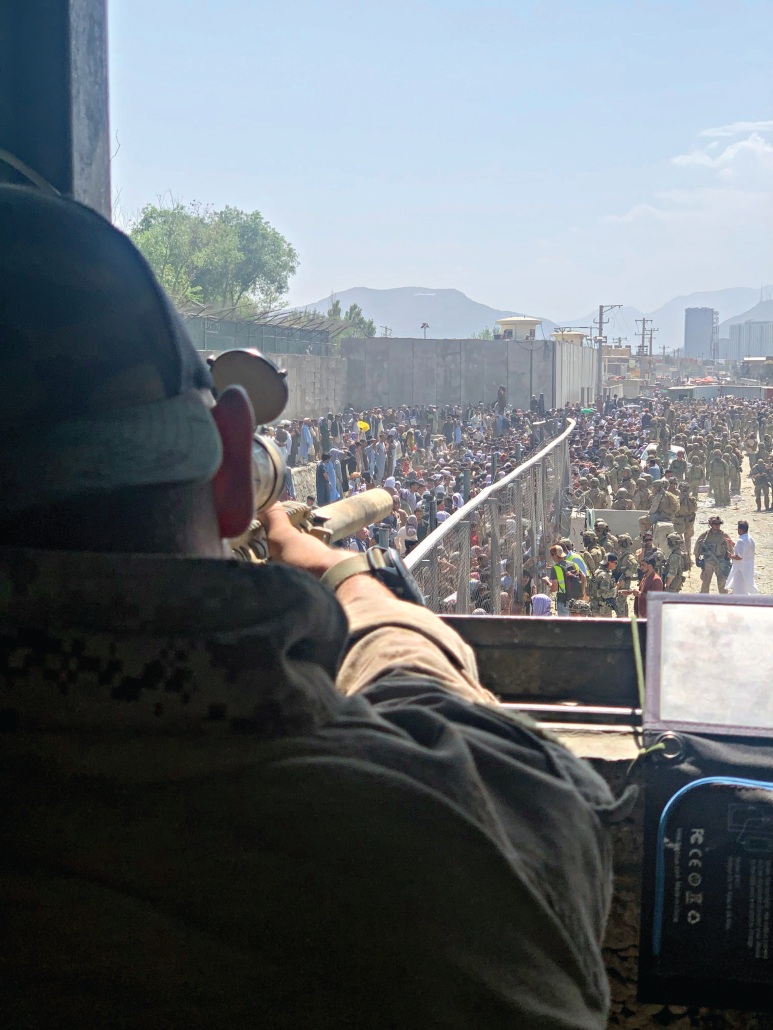
Turmoil enveloped the world within the snipers’ view. A sea of people pressed toward Abbey Gate from up and down the canal. Other Marines from 2/1 held the ground outside, struggling to keep the peace. The canal proved to be an open sewer, and the Marines nicknamed it “shit creek.” The smells of feces, urine, blood and decaying bodies rose into the tower, creating a toxic and intolerable environment around the gate, but the filth and stench failed to dissuade civilians. They waded through the knee-high water up to the side nearest the gate. Marines stood on the wall preventing some from climbing out and helping up others who showed appropriate documents.
Less than 200 yards down the road, a bridge spanned the canal, leading out of the airport toward the Baron Hotel. The British set up their base of operations there, processing people for evacuation. Maintaining the path of entry and exit for the Brits was critical.
Marines worked for hours clearing the road in front of Abbey Gate. The sheer weight of the desperate crowd seemed impossible to push back. After nearly 24 hours, 2/1 finally cleared the road out to the bridge over the canal. Engineers hauled in large shipping containers and placed them in a chevron-shape at the bridge, blocking vehicle entry to the gate.
The chevron morphed into one of the great incongruities representing those ending days of the war in Afghanistan. Taliban soldiers, operating in partnership with U.S. forces, occupied the chevron as an outer checkpoint. Their armed presence at this blocking position prevented the possibility of vehicle-borne improvised explosive devices (VBIED) from reaching Abbey Gate. In theory, the Taliban also provided an initial screening of civilians for evacuation. To the Marines of Reaper 2 observing the Taliban from their sniper tower, reality appeared quite different.
“We saw people getting beaten and executed, but there was nothing we could do,” remembered Sgt Hannigan. “At different points, we’d see the Taliban sit down on the shipping containers and grab a couple kids and the kids would just sit up there with them. What the Taliban were doing with their families I don’t know. But it was just weird seeing a toddler holding their baby brother or sister, sitting up there in the heat alone with the Taliban.”
Random shootings at the chevron drove civilians into the canal, where they bypassed the Taliban checkpoint. The Taliban presence left everyone on edge although the crowd remained mostly peaceful.
Marines arriving at Abbey Gate found themselves in a position no training could prepare them for. DOS officials appeared sporadically and in short intervals over the first several days. They alone made the determination on “acceptable” documentation for evacuation. They operated inside the gate, however, and Marines outside acted independently to determine who should be let in. Every Marine recognized an American passport or green card and identified those rare individuals to be let in but what does a German work visa look like? Or an Australian visa? What if a civilian handed you a cellphone and an English-speaking voice on the other end claimed to be a congressman or a colonel or someone else “important” enough to vouch for the person who handed you the phone?
Complicating matters, guidance on acceptable documentation shifted constantly. Just like 1/8 experienced at North Gate, 2/1 Marines grew frustrated and exhausted as they processed civilians through to safety, only then to discover the papers they possessed were unacceptable. Hundreds of civilians fit inside the inner holding area at Abbey Gate awaiting DOS approval. Sometimes, more than 2/3 of these groups were forced back out.
Desperation grew as time passed. Families stood on the road or in the canal for days. Many succumbed to thirst and heat exhaustion. Whenever DOS personnel left or the airfield shut down flight operations, processing halted. The crowd grew agitated and teetered on the brink of rioting. Marines witnessed unimaginable scenes as men, women, and children trampled each other to death, were crushed against concrete barriers, or were left for dead in the canal.
Marines clung to a sense of decency. They wanted to help but felt incapable in the wake of so much terror and tragedy. Even so, opportunities arose. Without clear guidance, young Marines acted independently, making decisions that meant life or death for people outside the gate.
“The first couple days I was looking around to see everybody else’s reaction, or to see how they handled things, but eventually I realized it doesn’t come down to me asking somebody if I can do something if it’s going to help,” said Cpl Markland. “It came down to understanding that right now, no decision is the worst decision for these people.”
Markland found a distraught family at North Gate one day, just after they made it through the initial screening. The family of five entered HKIA, prepared to leave their entire lives behind with a single blue backpack. It contained all their money, documents, and whatever other possessions they could fit inside. Somehow, the backpack disappeared. The frantic mother approached Markland with broken English, explaining their bag went missing during the initial search. As Marines held the family off to the side, Markland backtracked into the holding area looking for the bag. He spotted a blue bag in the crowd, but another civilian claimed it. Markland finally gave up and returned. The mother begged Markland to take her with him to search a second time.
He knew the uncleared civilians presented a security risk and taking her back through the entrance created a problem for everyone else trying to get in. He also understood that without the backpack, the family would not have the required documents and would be kicked out. He took the risk. They walked 100 yards back towards the gate. The woman immediately identified her bag as the one Markland had noticed before and retrieved it from the other civilian, who offered no resistance. They returned to the rest of the family, who wept with joy and thanked Markland for his help.
At another point near North Gate, Cpl Straight received the task of guarding an Afghan interpreter named Reggie. Reggie served with U.S. forces as an interpreter in 2012, then immigrated to the U.S. and enlisted in the Marines. After serving his time on active duty, he returned to Afghanistan as an interpreter once more. Now, Reggie sought evacuation to the U.S., and Straight helped him search the crowds for his wife and children. Miraculously, they found Reggie’s family and got them on a plane.
In the personnel terminal, GySgt Marnell learned firsthand how the smallest of gestures meant the world to the civilians. She found a refrigerator full of water bottles and took several out to a crowd waiting to board their plane. After enduring the heat with no food or water for days, the people beamed with gratitude. Marnell and one of her Marines made trip after trip, emptying the fridge for the people outside.
“I’ve never seen someone so thankful for something so minor in my life,” she remembered. “That was the one time I was happy over there, doing something so small for those people.”
Of all the Marines immersed in the good and the bad playing out at HKIA, the Female Engagement Teams (FETs) held a unique role. Afghan culture dictated women and children could only be handled by females. Female Marines across the commands on deck formed together to support processing operations. The significant number of women and children present and the limited number of female Marines available required the FETs to work non-stop.
“They were being worked to a degree where they didn’t have any down time,” said Markland. “We at least changed between the gate, the airfield perimeter, and rest. They didn’t have that as much, it was just gate to gate to gate. And the things they were being used for, with the women and kids, was very emotionally draining.”
Some of the most widely publicized photos to come out of HKIA featured FET members caring for babies. Many desperate families handed their babies to Marines over the gates or left them lying outside where they knew Marines would rescue them, just to give the kids a chance at life. An orphanage was formed on the airfield to care for and protect all the children separated from their parents. Marines cherished the moments playing with all the kids, while wrestling inside with the terrifying reality surrounding them.
Marnell waited with three young girls for their flight out of HKIA. The girls and their parents were cleared and approved for evacuation, but the youngest of them was still unaware of their circumstances. The girl, only 4 or 5 years old, pulled off her bracelets and handed them to Marnell.
“You can have these,” the girl said. “I won’t need them when the Taliban kill me.”
Marnell stared, taken off guard. How could this be the thought of a 5-year-old? She noticed the girls all wore a cross on a necklace. She learned the girls’ parents were English teachers at a school. Marnell reassured the girls they were safe now, held them, and stayed with them until they boarded their flight.
As days passed, units at the gates adopted rest plans to finally relive those who had been on guard for days. Many Marines endured 72 hours or more without sleep. They cycled back for rest and witnessed some results of their work; C-17s loaded with civilians taking off.
By Aug. 25, the situation declined from bad to worse. The President’s deadline to withdraw from HKIA by Aug. 31 approached and the crowds understood their chances of evacuation diminished rapidly. Their desperation increased proportionally. Marines felt the pressure, not just from the crowd surrounding the airport, but from desperate people around the world. An avalanche of “special requests” overwhelmed the Marines. Thousands upon thousands arrived in every way imaginable; from the White House to the Vatican, from congressmen to retired colonels, foreign officials, or anyone with someone they knew still outside the airport. The senior officers at HKIA received emails from the highest levels of government. Lance corporals at the gates who still had working phones found their numbers somehow had gotten out, and they received texts or phone calls about specific people to look for in the crowd. Sometimes the special requests helped identify individuals in the sea of people. More often than not, the special requests, and corresponding efforts to act on them served only to disrupt or even cripple the mass evacuation efforts.
Credible threat streams reached the intelligence community. VBIEDs threatened North Gate with the civilian road running parallel to the wall. Suicide vest IEDs (SVIEDS) were suspected as well with detailed descriptions of bags and people to watch out for. The threat at North and East Gates increased so dramatically that both entrances permanently closed operations. Abbey Gate remained the only operational entrance for civilians to enter. By nightfall on Aug. 25, commanders decided to also close Abbey Gate for good.
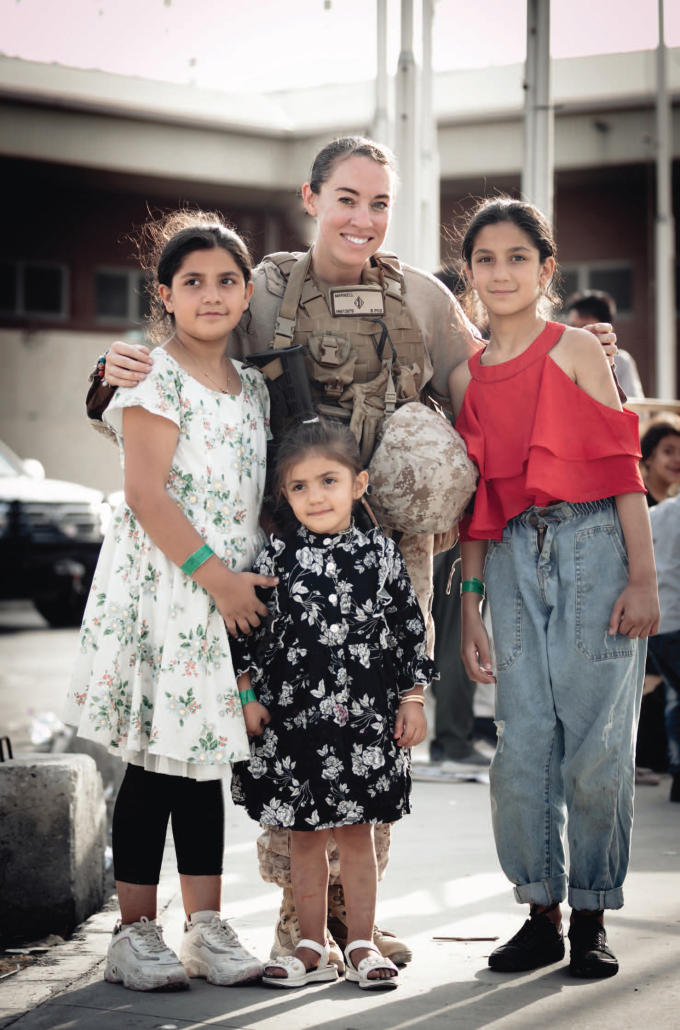
Cpl Straight arrived at Abbey Gate the morning of Aug. 26 with the task of barricading the gate once Marines from 2/1 pulled back inside. The morning wore on and operations continued as normal, but no word came to shut it down. Straight asked around about the delay. The Brits continued operating out of the Baron Hotel with the road from Abbey Gate as their only means of reaching the airport. Until they ceased processing civilians, the Marines needed to keep Abbey Gate open.
The closure of North and East Gates forced an influx of people toward Abbey. Civilians filled the canal and walkway. The frustrated crowd boiled over, throwing trash left on the ground, and grabbing at the Marines’ gear. Marines used flash bangs and other crowd control measures but found little success. Some Marines witnessed one man hold a baby over his head as a tiny human shield when a flash bang exploded nearby. Other civilians threw their children at the wall in a last hopeless act.
“Moms were trying to give away their kids. They would throw the kids to us,” stated one Marine in an interview from Central Command’s declassified investigation into the attack at Abbey Gate. “We didn’t have a choice then because the kids would be hurt. You’d be surprised how many people threw babies. You have no idea.”
“They would throw the kids over the fence, hitting the ground,” stated another Marine in the investigation. “Throwing like baseballs. It was crazy.”
IED threats poured in, adding to the mayhem. Marines were told to look for a black backpack with white arrows, but bags and suitcases littered the entire area. Intel provided a full description of a clean-shaven man as a possible suicide bomber. Snipers from Reaper 2 spotted a man matching the description in the crowd and reported the sighting. Other Marines spotted suspicious individuals acting far too calm amid the chaos, observing the gate and taking pictures.
Several reports of an imminent attack arrived throughout the day. On at least one occasion, an incredibly specific IED report arrived with a countdown. Marines received the warning with 10 minutes until detonation, then reiterated at five minutes. Snipers in the tower took shelter and the search platoon outside the gate knelt behind a concrete barrier. Everyone remained sheltered well beyond the expired timeline before resuming operations. The substantial increase in threats led the Marines to collapse back from the road leading to the chevron and hold a small perimeter around the outer gate.
First Platoon from Golf Company, 2/1, assumed duty outside the gate, lining the canal wall directly below the sniper tower. Three FET members exited the gate helping to pull women and children from the canal. A U.S. Army psychological operations (PSYOPS) vehicle arrived at the gate to assist with crowd control. One official estimate placed 2,000 to 3,000 civilians at Abbey Gate. At around 5:40 p.m., roughly 30 minutes after the PSYOPS team arrived, a bomb detonated.
The suicide bomber stood on the opposite side of the canal, directly across from the Marines. The explosion immediately killed or wounded hundreds of people packed into the area beneath the sniper tower. Tear gas canisters held by Marines closest to the blast ruptured, spreading their contents in a cloud over the scene. Screaming civilians fled the area along the canal. Bodies piled against the canal wall, blocking their path and restricting escape.
Cpl Straight stood inside the gate nearly 200 feet away. Even at that distance, the blast wave knocked him off his feet. Sgt Hannigan had just returned to the sniper tower and parked his truck inside the gate less than 100 feet away. He immediately climbed up the tower and found several of his Marines dazed and concussed. He learned one team member, Sgt Tyler Vargas-Andrews, was wounded on the ground outside.
Marines sprinted from every direction toward the unfolding mayhem. Some assumed security positions, expecting a complex ambush or follow up IED. Gunfire filled the air after the blast. Several Marines interviewed for the CENTCOM investigation reported armed men in a building on the opposite side of the canal. Others witnessed men on their cellphones or taking pictures.
In the sniper tower, Sgt Hannigan ducked as three rounds struck a window facing the canal. The bulletproof glass splintered but stopped the incoming fire. Marines outside on the ground opened fire briefly, some at perceived targets, others blasting warning shots into the air to keep people back from the casualty evacuation efforts.
Marines grabbed stretchers, riot shields, and anything else that could carry the wounded. Navy corpsmen and Marines applied tourniquets and plugged puncture wounds with their fingers. The number of civilians, dead, alive, and wounded, piled up or running for their lives, complicated all efforts to help. The individual decisions of Marines on the ground remained the only thing holding the situation together.
A chain link fence separated the majority of the casualties from the Marines attempting their rescue. Thinking quickly, Reaper 2 team leader, Sgt Charles Schilling, grabbed a pair of bolt cutters and cut a hole in the fence. This single action dramatically reduced the time it took to reach the wounded.
Sgt Jonathan Painter received shrapnel wounds from the explosion but overcame the chaos and pain to set his squad in a security position along the canal before running into the tear gas to help evacuate the wounded. Cpl Wyatt Wilson was blown through the air with ball bearings peppering his entire body. Somehow, in spite of his own grievous injuries and the cloud of tear gas enveloping him, Wilson found another critically wounded Marine lying nearby and dragged him to safety until blood loss prevented him from going farther. Wilson passed the Marine off but refused care for his own life-threatening wounds. Numerous other Marines, corpsmen, and Army medics put themselves at risk to help their brothers and sisters, as well as the wounded civilians.
As of this writing, the majority of them have gone unrecognized. Sgt Schilling’s life-saving initiative making the hole in the fence is just one example of unrecognized actions. Sgt Painter received the Navy and Marine Corps Commendation Medal with combat “V.” Cpl Wilson received a Bronze Star with combat “V.”
In less than 15 minutes, all American casualties, both dead and wounded, were evacuated to the initial casualty collection point. Medical facilities at HKIA overflowed. Aircraft departed with the most severely wounded. The rapid evacuation of casualties no doubt prevented more Americans from losing their lives. In fact, it happened so quickly that those responsible for patient tracking struggled to keep up, temporarily misidentifying some of the dead or wounded. In total, the explosion killed 13 U.S. servicemembers and initially wounded close to 30. This number grew in the following weeks as concussions and traumatic brain injuries connected to the blast were identified. More than 150 Afghan civilians died in the attack with an untold number wounded.

Following the evacuation, Abbey Gate fell eerily quiet. The civilian crowd disappeared, leaving stacks of bodies piled against the canal wall or floating in the water. The ground attack alarm blared from speakers across HKIA, providing the only background noise. Taliban soldiers remained at the chevron, where they observed and filmed the attack in silence. Engineers blockaded the gate. From then on, apart from special requests, evacuation operations ceased.
On the morning of Aug. 27, explosive ordnance disposal Marines conducted a post-blast analysis. They concluded the bomber utilized a suicide vest or backpack containing 20 pounds of explosives and hundreds of ball bearings. He detonated the device from the canal wall opposite the Marines outside the gate, only 20 feet away.
At noon, U.S. servicemembers gathered on the runway at the ramp of a C-17. One by one, pallbearers escorted 13 flag-draped caskets onto the aircraft. The lives claimed by the attack ranked as one of the highest numbers of U.S. fatalities in a single incident from the entire 20-year war in Afghanistan.
Marines spent the final days before the Aug. 31 deadline preparing to leave. Many engaged in the “demilitarization” of the airport. The intent was to deny the Taliban use of any military equipment. Hundreds of vehicles, aircraft, weapons, computers, radios, and every other type of gear imaginable would be left at HKIA. Commanders tasked the Marine and U.S. Army units with destroying all of it. Marines dropped thermite grenades through engine blocks, slashed tires, and smashed control panels to pieces. Sledgehammers, halligan bars, axes, and anything else they could find replaced rifles as their chosen weapons of opportunity. However, the “demil” order originated, the expectation of what should be destroyed swiftly expanded in its translation down to those carrying it out. At the gates, Marines were often left on their own to make life and death decisions for civilians. Now, throughout the airport, Marines were left on their own to decide what items warranted destruction.
“The Turkish military left their barracks, and we were standing in their living quarters,” remembered Cpl Markland. “We just thought OK, if we aren’t going to be here to use it, then certainly not the Taliban. We were going to do everything we could to make it uninhabitable for them. We were going to take away the amenities that anyone would appreciate.”
Marines smashed TVs and refrigerators. They broke apart tables and chairs. They forced open every locked door and demolished anything found on the other side. Across the airport, Marines everywhere unleashed nearly two weeks of pent-up anxiety and aggression. They felt helpless in the face of ongoing horror outside the gates. They thirsted for revenge in the wake of the attack that killed 13 of their brothers and sisters. Every window begged to be smashed. Every blank wall space looked naked without “F–K ISIS” in spray paint. Before them lay an entire base full of cathartic opportunity.
HKIA reserved a final bad memory for many Marines. In their last hours on the ground, Marines were ordered to police call the airport and clean up the destruction just completed. They were told that they took the order too far. They returned to specific areas to pick up the pieces and flip vehicles back onto shredded tires. Some unlucky few were stuck policing the areas where civilians waited in groups to board aircraft. Without adequate facilities, civilians defecated in whatever container they had or directly on the ground. Trash and filth of every kind imaginable remained. The police call seemed a fitting end to their time in Afghanistan.
The final American aircraft lifted out of HKIA before midnight on Aug. 30, completing the largest NEO airlift in U.S. history. Officially known as Operation Allies Refuge (OAR), 800 military or civilian aircraft evacuated nearly 125,000 civilians over a 17-day period.
The impressive numbers did little to assuage the feelings of the Marines who endured HKIA. Now two years later, the memories are ever-present, and reminders are constant. Tyler Vargas-Andrews, the Reaper 2 team member severely wounded by the blast, gave a compelling testimony before Congress in March, highlighting the questions and concerns about the operation echoed by many Marines. As recently as April, the Taliban announced they killed one of the key ISIS-K players who planned the bombing at Abbey gate.
In August 2022, on the one-year anniversary of the attack at Abbey Gate, Cpl Joe Laude worked through the contact list on his phone, checking in with everyone he knew from HKIA. Laude served as a machine-gunner with Echo Co, 2/1, working at Abbey Gate and rushing 100 meters to the scene of the attack to evacuate casualties after the bomb went off. An idea arose; rather than contacting everyone individually, what if he created a hub where everyone could come for community when they needed it?
“At that one-year anniversary, I already knew OAR veterans had a lot of unanswered questions, a lot of guilt and shame about their service,” Laude said. “I needed to do something.”
He formulated a plan and worked with others to develop the idea. The group founded a 501(c)(3) called OAR Foundation with the mission to provide a community for OAR veterans, preserve the history of the evacuation, and explore the operation’s “moral injury” on those who were there.
“Moral injury is a guilt or shame-based ailment,” Laude explained. “It can be co-occuring with post-traumatic stress, but I think the biggest difference is the guilt. I think many times, the guilt is what can more quickly lead someone toward suicide. We are slowly researching all of these things and recently brought on a psychologist into the organization to help us build up that research.”
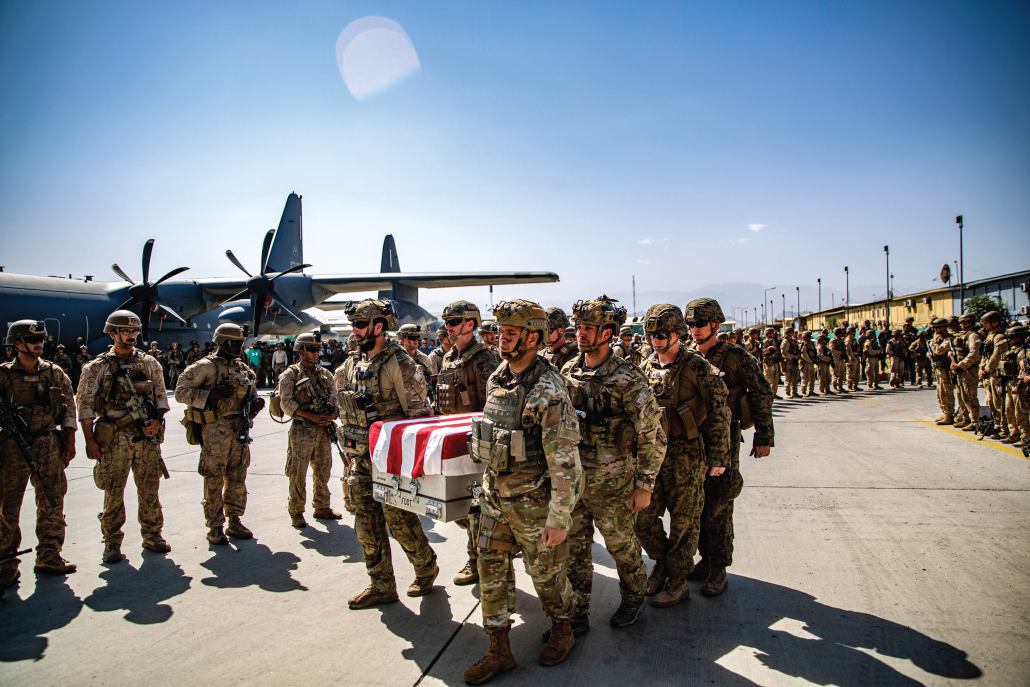
As the vast majority of OAR veterans leave the Corps or move on to different commands, they try to decipher how that horror-packed two weeks will fit into the rest of their lives. Even for veterans with combat deployments prior to August 2021, HKIA held experiences unlike anything they had ever seen before. OAR Foundation hopes to play a key role in finding answers and accountability, while providing a forum for veterans to share their experience. As they forge ahead, those stories will shape the legacy of the Marines and Navy corpsmen whose lives were changed at HKIA and preserve the memories of the 13 servicemembers killed in action.
The lessons learned from this tragedy remain in infancy, even two years later. Most will only be revealed as more truth comes to light. When something horrific occurs, the duality of man emerges. The evacuation of HKIA brought out the worst that humanity has to offer. It also brought out the best. No matter how bad it gets, no matter how completely evil holds the day, there will always be someone willing to act for good, even in the face of chaos and utter exhaustion. Someone will always be willing to hold the line. At HKIA, Marines held.
Author’s note: Our tribute to the fallen servicemembers from HKIA is on page 72 of this month’s issue. For the Marines who served at HKIA, thank you for allowing me to share a glimpse into your experience. Each of you has a story worth telling. I encourage you to do so. It would be impossible to capture everything that happened there in one article. I hope my efforts have done you justice. For more information on OAR Foundation, visit www.operationalliesrefugefoundation.org. For additional photos and information about HKIA and the attack at Abbey Gate, see the expanded version of this story at www.mca-marines.org/magazines/leatherneck/.


